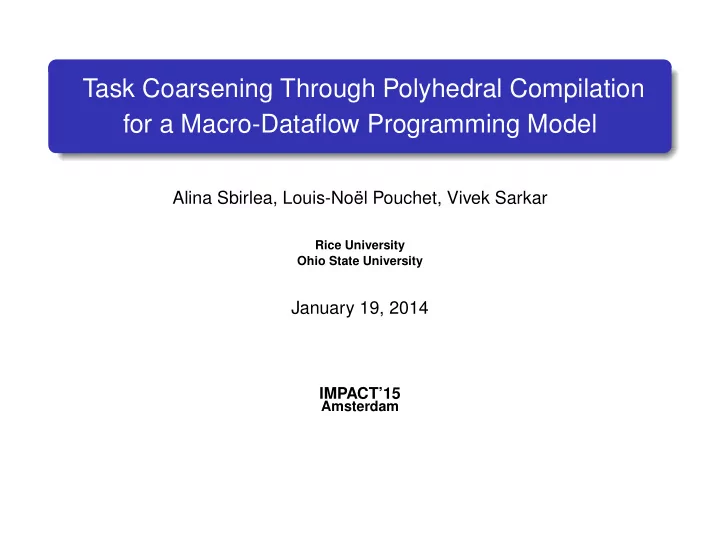

Task Coarsening Through Polyhedral Compilation for a Macro-Dataflow Programming Model Alina Sbirlea, Louis-Noël Pouchet, Vivek Sarkar Rice University Ohio State University January 19, 2014 IMPACT’15 Amsterdam
Overview: IMPACT’15 DFGR and HC mming item Rice/OSU 2 T runtime,
Overview: IMPACT’15 Poster Task ¡Coarsening ¡Through ¡Polyhedral ¡Compila5on ¡ ¡ IMPACT 2015 for ¡a ¡Macro-‑Dataflow ¡Programming ¡Model ¡ Alina Sbirlea 1 , Louis-Noel Pouchet 2 , Vivek Sarkar 1 1 Rice University, 2 Ohio State University DFGR: Data-Flow Graph Representation Transforming DFGR graphs for task+data coarsening DFGR DFGR to Polyhedra Polyhedra to Polyhedra Polyhedra to DFGR § Has two components: § Textual component: § Support the subset of DFGR programs without non- § Transformation objective for DFGR on CPU: increase § Generate C code implementing the tiled schedule affine expressions, uninterpreted functions, nor data- task granularity to have less tasks computing on more using CLooG [Bastoul,2004] § high-level view for domain experts dependent get/puts (e.g., [A : [B : i] ]) data and reduce communication. § New DFGR tasks are created for each tile body § Conversion to polyhedral representation (SCopLib) § Use iteration space tiling on the polyhedral generated § IR component: § C reate iteration domains by propagating the tag representation with the PLuTo algorithm [Bondhugula et § Dependence between tiles are modeled by describing § automatic generation from higher-level programming functions in step prescriptions al,2008] the data flowing between tiles (read/written) § Create access functions directly from item tag functions § Input is polyhedral representation + dependence § Data flow of the transformed program extracted by systems § No schedule created polyhedra, run PLuTo as-is and obtain a schedule for polyhedral analysis, after updating also the data § Extract dependence polyhedra: DSA form ensures only § Uses current software and compilers: the transformed program as well as tiled iteration layout with tiling of data in item collections flow dependences: no need for any schedule to domains § DSA on data tiles may not be preserved but the § Habanero-C provides a parallel task language with determine which instance is the producer or consumer transformed code is still DSA: use “fake” item for RAW Smith-Waterman example collections to make the DFGR graph DSA if multiple extensions for OpenCL code generation tags write to the same tile § OCR for a distributed execution C code Dependences § TLDM generation for FPGAs A[0][0] = corner(); § Proposes the use optimizations at the IR level. for (j=1; j<NW; j++) A[0][j] = top(j); § See DFM’14 publication by Sbirlea, Pouchet and Sarkar for (i=1; i<NH; i++) \{ A[i][0] = left(i); Textual DFGR Constructs for (j=1; j<NW; j++) DFGR regions as iteration spaces: A[i][j] = center(i, j, A[i-1][j-1], • Item collection declarations A[i-1][j],A[i][j-1]; \} a hierarchy of concepts § [int* item1]; [float* item2]; Input DFGR Transformed DFGR § Ranges: model rectangles, suited for simple regular • Step collection declarations < int A>; computations < int ** A >; § (step1 : a, b) @CPU=val1, GPU=val2, FPGA=val3; (corner:i,j) -> [A:i,j]; (newStmt1 : c1, c2) -> [ A : c1, c2]; [A:i,j-1] -> (top:i,j) -> [A:i,j]; § Simple polyhedron: affine inequalities; powerful static analysis [ A : c1, c2 -1 ] -> (newStmt3 : c1, c2) -> [ A : c1, c2 ]; [A:i-1,j] -> (left:i,j) -> [A:i,j]; • Step prescriptions & transformations [ A : c1-1, c2 ] -> (newStmt2 : c1, c2) -> [ A : c1, c2 ]; [A:i-1,j-1], [A:i-1,j], [A:i,j-1] -> [ A : c1-1, c2 ], [ A : c1, c2 -1 ], [ A : c1-1, c2 -1 ] -> § (step1 : i, j) :: (step2 : i+1, j*j); § Union of Z-polyhedra: generalization of polyhedra, analyzable (newStmt4 : c1, c2) -> [ A : c1, c2 ]; -> (center:i,j) -> [A:i,j]; env::(corner:0,0); < regnewStmt2 : c1> { max(1,0)<= c1 <= floord(NH, 32) }; using modern polyhedral compilation frameworks • Step I/O relations < regnewStmt3 : c2> { 1<=c2<=floord(NW, 32) }; env::(top:0,{1 .. NW}); § Union of arbitrary sets: most general; includes uninterpreted < regnewStmt4 : c1, c2> { max(1,0)<= c1 <= floord(NH, 32); env::(left:{1 .. NH},0); § (step2: bar(i, j), j) -> (step1 : i, j); 1<= c2 <= floord(NW, 32) }; functions (foo(i)) env::(center:{1 .. NH},{1 .. NW}); env :: (newStmt1 : 0, 0); § [item1: i-1, j-1] -> (step1 : i, j+1); [A:NH,NW] -> env; env :: (newStmt2 : regnewStmt2 , 0); § (step1 : i, j) -> [item1 : i, j], [item2 : i+1, j]; env :: (newStmt3 : 0, regnewStmt3); env :: (newStmt4 : regnewStmt4); Key Features • Ranges and Regions § Steps are functional Performance results on 16-core Intel E7330 @ 2.4 GHz § [item1 : {i-1,i+1},{j-1,j+1} -> (step1 : i, j); § Item collections implement Dynamic Single Assignment form § <region1 : i, j> { 1 <= i, i <= M, 1 <= j, j <= N }; § Data type in collections can be arbitrary (w/ serializers) § env::(step1 : region1); § Dependence between steps with step-to-step dependence or via § <region2(p, q) : i, j> { p-1 <= i, i <= p+1, q-1 <= j, j <= q+1 }; data dependence § (step1 : i, j) -> [item2 : region2(i,j)]; § Use tags as unique identifiers for step instances and items in • Environment collections § env :: (step1 : region1); § Tag values may be known only at runtime or at compile-time (a) Input sequence sizes: 400 × 400. (b) Input sequence sizes: 800 × 800. (a) Input sequences: 10k × 10k. (b) Input sequences: 50k × 50k. § env -> [item1 : region1]; [item2 : region1 ] -> env; § Natively represent task-level, pipeline and stream parallelism Rice/OSU 3
Recommend
More recommend